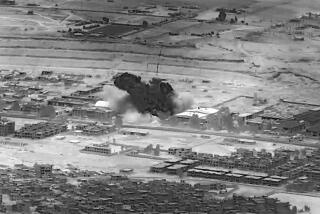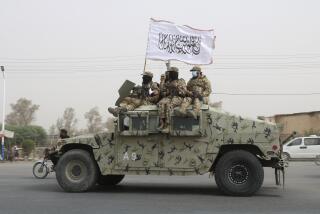Despite Grim Predictions, U.S. Battle Toll Still Zero
- Share via
WASHINGTON — After nearly seven weeks, the unconventional war in Afghanistan has produced an unlikely statistic: Not one U.S. service member has been killed by enemy action.
Although this record could change quickly, it has nonetheless been greeted with surprise and quiet relief at the Pentagon, where officials have warned from the outset that Americans needed to be prepared for substantial casualties.
Even in a seemingly lopsided contest, “you expect casualties when bombs fly,” said one military official, who recalled that the war opened amid widespread predictions that Afghans would bloody U.S. forces just as they did the Soviets during the 1980s.
The casualty rate reported by the Pentagon attests to the continuing technological advances that the U.S. military has made in developing an arm’s-length, precision style of attack. It reflects, too, the Bush administration’s caution in putting troops in harm’s way--despite polls indicating that Americans would support the war even if it involved a high number of casualties, experts say.
Coming after the 1999 air war in Yugoslavia, in which the U.S. suffered no combat losses, and the 1991 Persian Gulf War, in which there were relatively few, a low-casualty campaign in Afghanistan would reinforce Americans’ view that war can sometimes be waged with minimal casualties.
It may also reinforce an impression held in some parts of the world that U.S. military doctrine calls for the United States to use its advanced hardware--and for others to do the dying.
Clearly, many Afghans have been killed and injured since the U.S.-led campaign began Oct. 7. Although estimates are still largely guesswork, some experts believe that more than 1,000 Taliban and opposition troops have probably died in the fighting, along with at least dozens of civilians.
Pentagon officials have said that the intense bombing of Taliban front lines near the northern city of Mazar-i-Sharif and the capital, Kabul, proved deadly, judging by the relatively small number of Taliban troops who emerged from trenches when the radical regime began its retreat this month.
On the U.S. side, although there are thousands of troops, hundreds of warplanes and dozens of ships in the region, the Pentagon has reported six deaths to date, none caused by enemy action.
Two of those killed were crew members who died Oct. 20 in the crash of a helicopter supporting a special operations assault near the Taliban’s southern stronghold of Kandahar. Three sailors were killed in two maritime accidents, and the sixth fatality was an airman who died in a forklift accident, according to U.S. Central Command.
There have also been 14 noncombat injuries that Central Command has considered serious enough to report. Thirty-one Americans were injured in the Oct. 20 raids on Kandahar, but authorities insist that the injuries were all minor.
‘Close Combat’ but No Deaths
Michael Vickers, a former Army Special Forces officer, said the U.S. casualty record is especially striking considering that Special Forces have been engaged in ground fighting for weeks.
He noted that some U.S. troops were with opposition forces when they entered Mazar-i-Sharif two weeks ago and that some had been ambushed and, in at least one case, even overrun by hostile forces.
“There’s been some close combat,” said Vickers, an analyst at the Center for Strategic and Budgetary Assessments think tank. “So it’s been pretty remarkable.”
Military officials suggest that the current phase of fighting could bring U.S. casualties. An increasing number of Special Forces troops is on the ground helping opposition forces and conducting a search for Osama bin Laden and the Taliban leadership.
Officials say they may soon bring in hundreds of Marines, trained in counter-terrorism, to support the Special Forces and possibly assist in the search for Bin Laden. Bands of hostile troops still roam the countryside, and there is the risk of ambush and sabotage, as well as the threat posed by the hundreds of thousands of land mines that litter the country, a legacy of more than two decades of war.
U.S. leaders gave no sign that they were prepared to quickly mobilize an American conventional ground assault on the Taliban if the opposition Northern Alliance forces had proved not up to the task.
And despite their urgent desire to bring down Bin Laden, U.S. military leaders have repeatedly declared that they would not send American forces on risky missions into tunnels or caves, although they might encourage Afghans to take on that dirty duty.
America’s specialized approach for reaching enemies in caves, Marine Gen. Peter Pace said this week, “is to put 500-pound bombs in the entrance.”
Ivo Daalder, a former National Security Council aide now at the Brookings Institution in Washington, said he believes that the administration has been “significantly constrained” by its fear of large casualties.
Despite the Pentagon’s remarkable record in avoiding combat casualties in the past decade, Daalder said, he doesn’t believe that Americans would come to expect wars of “immaculate coercion,” as some pundits have predicted.
“I think there is still an appreciation that war is a dirty business and people will get killed in it,” he said.
But Daalder said the U.S. casualty record could reinforce the impression abroad that Americans want others to bear the risks of casualties in wartime. At the same time, analyst Vickers said, the no-casualty record could also have a positive effect by impressing potential adversaries with U.S. military skill, and thus helping deter aggression.
“You could get some resentment because it looks so easy for us,” Vickers said. “But it creates some awe as well. . . . We want to minimize the resentment and maximize the awe.”
More to Read
Sign up for Essential California
The most important California stories and recommendations in your inbox every morning.
You may occasionally receive promotional content from the Los Angeles Times.














